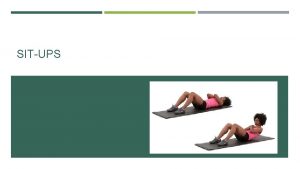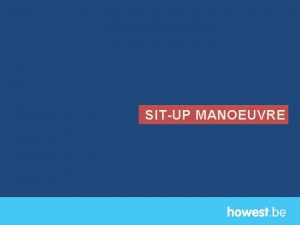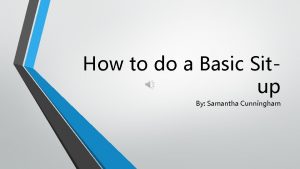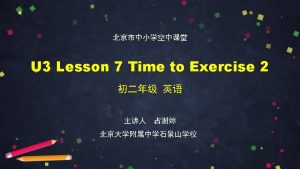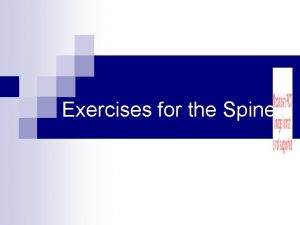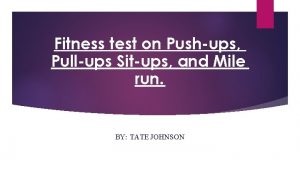SITUPS SITUPS The situp or curlup is an














- Slides: 14

SIT-UPS

SIT-UPS The sit-up (or curl-up) is an abdominal endurance training exercise to strengthen and tone the abdominal muscles. It is similar to a crunch (crunches target the rectus abdominis and also work the external and internal obliques), but sit-ups have a fuller range of motion and condition additional muscles.

WHAT MUSCLES ARE USED TO DO SIT-UPS Sit-ups target the abdominal muscles, including rectus abdominis, external and internal obliques, iliopsoas and rectus femoris. Rectus Abdominis The rectus abdominis is the wall of the abdominal muscle that connects to the lower rib cage and the hips. When built up so that it bulges against its crossing tendons, it creates the six-pack effect. Its purpose is to tilt the rib cage and the pelvis toward each other. Like all abdominal exercises, the sit-up should be performed with the back at least slightly rounded at all times to protect the spine. This contraction works the rectus abdominis.

Internal and External Obliques The external obliques also attach to the rib cage and the pelvis, but either side of the rectus abdominis. They are the principal muscles for twisting the body back and forth and for tilting the rib cage from side to side. When contracted simultaneously, however, they aid the rectus abdominis in crunching the rib cage directly toward the pelvis, such as occurs during a sit-up. Iliopsoas This is where the sit-up begins to differentiate itself from the crunch. The iliopsoas attaches to the lower spine and high up on the hips and to the upper front of the femur. Their function is to bend the body at the hips. Usually, this is to lift the thigh toward the torso, but in the case of sit-ups, it's to lift the body toward the thighs. Proportionately, they are very weak compared to their antagonist's muscles, the gluteus maximus, which are some of the largest and strongest muscles in the body. This is one good reason to work with them with sit-ups.

Rectus Femoris The rectus femoris is one of the four heads of the quadriceps, the large muscles of the front of the thigh. All four heads of the quadriceps attach to the patella or knee cap. Their primary function is to straighten the leg at the knee. While the other three heads of the quadriceps attach to the upper femur, the rectus femoris crosses the hips, attaching to the pelvis. There, it aids the iliopsoas in flexing the hips — or lifting the torso toward the thighs — during a sit-up.

HOW TO DO SIT-UPS To perform a proper situp: 1. Lie down on your back. 2. Bend your legs and place feet firmly on the ground to stabilize your lower body. 3. Cross your hands to opposite shoulders or place them behind your ears, without pulling on your neck. 4. Curl your upper body all the way up toward your knees. Exhale as you lift. 5. Slowly, lower yourself down, returning to your starting point. Inhale as you lower.

BENEFITS OF DOING SIT-UPS o No Need to Buy Equipment or a Gym Membership. One of the many benefits to doing sit ups is the cost involved, as it only costs you time and effort. That’s right, you do not have to buy a gym membership, you can do sit ups anywhere at anytime. o Sit-ups are one of the best exercises for your core. Sit-ups improve the strength of every set of core muscles, which enhances your ability to move and function on a day to day basis. Additionally, strengthening your core can improve the function of your organs, since having weak core muscles or bad posture can often put pressure on the organs that results in them being positioned improperly and losing some of their function. Strengthening your core is also good idea because the results will affect you for the rest of your life. If you continue doing core exercises, your body will deteriorate much slower and you’ll be able to outperform most of your friends as you reach old age!

o Sit-ups improve the overall health of your torso. That’s right! Aside from the obvious benefit of providing you with the chiseled six-pack that people admire, sit-ups improve the health of your torso. They work to strengthen your spinal erector muscles, which contribute to healthy posture and ensure that you don’t fall victim to injuries that might be caused during old age by a weakened spine. A strong spine prevents injuries that might occur due to a lack of strength. The improvement to stabilizer muscles means that you’ll be able to control the motion of your torso better, making you more nimble. They greatly improve core strength, which is focused around your torso and your center of gravity. Core strength affects almost everything physical that you do, including your balance and endurance. In conclusion, sit ups aren’t just great for making your torso look great, they help keep it healthy through a number of different mechanisms.

3 COMMON MISTAKES PEOPLE MAKES PULLING ON YOUR NECK The main mistake almost everyone makes on regular basis is using their hands for leverage. Doing this puts a strain on your neck and can only lead to injuries. The only reason your hands are behind your neck is so they could support your head. You shouldn’t use them to pull your body up because all the heavy lifting has to be done with your core. GOING UP TO FAST If you’re not a big fan of sit-ups, you probably want to finish them up as soon as possible, but doing it too quickly is actually hurting your progress. Move slowly so you can really feel the muscles working, and get the most of each sit-up. Changing direction, instead of simply focusing on forwarding motion, is also a good idea.

FEET ON THE GROUND Sit-ups should never be done with straight legs. If the knees are not flexed, you’ll probably end up putting too much pressure on the base of your spine. It’s also important to plant your feet firmly on the ground, so they wouldn’t be rocking up and down as you do the exercise.

CLASS MARKS NAME Nº OF SIT-UPS MARK Laura Abenza Vidal 22 7, 5 Ana Bahamonde Cortés 25 9 Elisa Belmonte García 22 7, 5 Nerea Boronat Ruiz 32 10 MªJosé Esteban Palazón 26 9, 5 Nayma Fernández Martínez 22 7, 5 Antonio José Garrido López 30 9

Luisa González Sandoval 27 9, 75 Raúl Jover Morata 28 8 Inés María López Fernández 25 9 José Manuel Martínez Tovar 30 9 Elena Medina Rodríguez 26 9, 5 Lucía Medina Ruiz 26 9, 5 José Méndez Frutos 23 5, 5 Agustín Navarro Martínez 36 10

Tina Alexia Rotaru 24 8, 5 Juan Sánchez González 30 9 Sergio Simmonds Egea 34 9, 75 Pablo Sirvent Blanes 27 7, 5 As no one failed the test, we have decided to mantain the standard you gave to us. Overall, we believe that the class physical condition is great. However, we should make more abdominal exercise in order to achieve the benifits mencioned before. After dealing with task, we realised that it is not easy to keep an eye on all the students and marking them as well as explaining and searching information about the exercise.

MADE BY: NAYMA FERNÁNDEZ MARTÍNEZ ELISA BELMONTE GARCÍA NEREA BORONAT RUIZ LAURA ABENZA VIDAL
 Benifits of situps
Benifits of situps đặc điểm cơ thể của người tối cổ
đặc điểm cơ thể của người tối cổ Các châu lục và đại dương trên thế giới
Các châu lục và đại dương trên thế giới Mật thư tọa độ 5x5
Mật thư tọa độ 5x5 Tư thế worm breton là gì
Tư thế worm breton là gì ưu thế lai là gì
ưu thế lai là gì Tư thế ngồi viết
Tư thế ngồi viết Thẻ vin
Thẻ vin Cái miệng xinh xinh thế chỉ nói điều hay thôi
Cái miệng xinh xinh thế chỉ nói điều hay thôi Các châu lục và đại dương trên thế giới
Các châu lục và đại dương trên thế giới Bổ thể
Bổ thể Từ ngữ thể hiện lòng nhân hậu
Từ ngữ thể hiện lòng nhân hậu Tư thế ngồi viết
Tư thế ngồi viết V cc
V cc Thơ thất ngôn tứ tuyệt đường luật
Thơ thất ngôn tứ tuyệt đường luật
